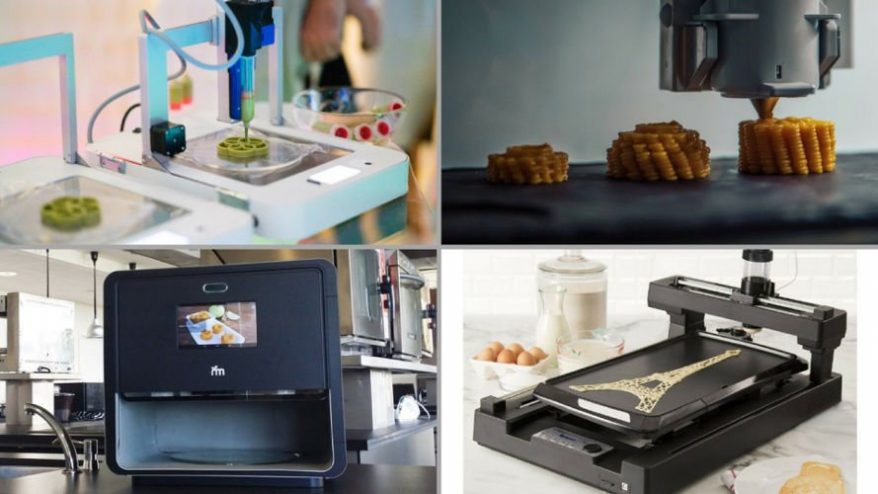
They’re here, and shaking up how we view and prepare food. Food 3D printers are usually hybrid FDM 3D printers that print food pastes rather than plastic filaments, printing delicious chocolate, jam or toffee layer-by-layer to create a custom dessert or savory dish based on your design.
Want to 3D print a model of your face in chocolate? Or print your company’s brand in biscuit to send to potential clients? You can do it all with food 3D printers.
Our ranking below features some of the best 3D printers for printing food, and compares them on accuracy, speed, variety of food types you can 3D printer, and more.
3DSourced is reader-supported. When you buy through links on our site, we may earn an affiliate commission. Learn more
The Best Delta 3D printers and where to buy them
| Name | Max Build Volume (mm) | Speed (mm/s) | Price | Where to buy for best price |
|---|---|---|---|---|
| Monoprice Mini Delta | 110 x 110 x 120 | 150 mm/s | $179 | Amazon here |
| FLSUN Q5 | 200 x 200 x 200 | 150-300 mm/s | $260 | Amazon here |
| He3D K280 Delta | 280 x 280 x 600 | 150 mm/s | $320 | Amazon here |
| FLSUN QQ-S | 255 x 255 x 360 | 300 mm/s | $379 | Amazon here |
| Frankensbox FX-800 | 150 x 150 x 175 | 150 mm/s | $299 | Amazon here |
| Monoprice Delta Pro | 270 x 270 x 300 | 150 mm/s | $699 | Amazon here |
| WASP Delta 2040 PRO Turbo | 200 x 200 x 400 | 500-600 mm/s | $3,400 | Amazon here |
- We’ve also written a feature story on 3D printed food.
- We also have a more specific ranking on the best chocolate 3D printers.

What is a Food 3D Printer?
Typical FDM 3D printing involves a 3D printer’s extruder depositing melted plastic filament along the dimensions specified in the STL file. It’s somewhat similar to icing a cake in that regard, but when you’ve completed one layer the next layer is then deposited on top of that existing layer.
3D printed food will have a layered appearance as FDM parts do — if you look hard you’ll see the tiny layers at slightly jagged angles like the steps on a pyramid, or a spring being pressed together.
With the icing a cake analogy, now assume that instead of icing, you can do the same action but with any edible food type. Chocolate, toffee, sugar, jam and savory flavors like tomato sauce / paste and cheese. Instead of being limited in the shapes you can make by the type of cake tin you use, you can now create incredibly intricate structures by perfectly depositing each part of food exactly where it is supposed to be.
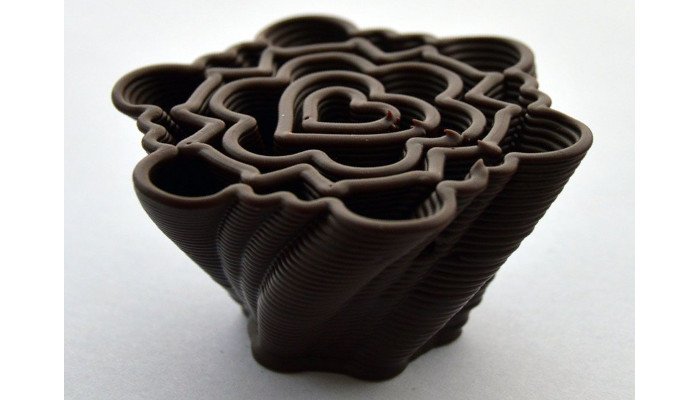
Food 3D printers are similar to FDM 3D printers — one printer on our list is a modified FDM printer — they deposit food instead of plastic filament in exactly the same way. This allows them to be more precise and accurate that any human could be, and also means that menial food jobs in restaurants and kitchens can be automated, saving time and energy.
What’s more, since you only extrude the exact amount of food you need, this makes for more efficient use of food, saving both money and the environment! This is a key and reoccurring theme in additive manufacturing.
Food 3D printers are gradually making their way into STEM education as a novel and fun new way of teaching both 3D printing skills and about what we eat. Food 3D printers for kids are also a great way of family bonding while creating something delicious to eat after, as well as by small businesses who want a new way of creating custom, up-market chocolates and other treats.
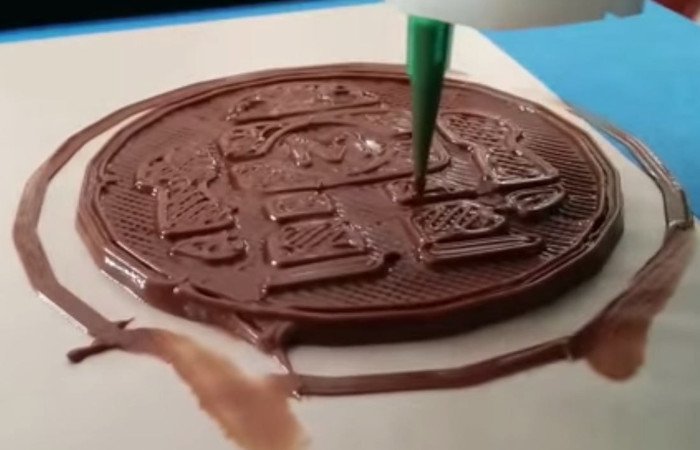
Benefits of a food 3D printer
- Better for the environment. 3D printed food materials can be created from alternative proteins like algae, leaves, and even insects, which are ground into a paste ready to be 3D printed. These ingredients otherwise would not be used, and are a form of protein and nutrients which may be key to future diets.
- Increased food customization. Though everybody’s food is already arguably customized, it isn’t to the level that food 3D printers offer. Not only can you create and pick the exact ingredients you want, but you can also create custom shapes and geographies that you want your food to occupy. Want a rabbit-shaped chocolate bar? Or an emoji-shaped burger? Easy. 3D printers conquer conquer the first three dimensions for you, saving you the fourth dimension — time.
- Saves time & stress. 3D food printers can automate the boring and repetitive kitchen tasks for you so you don’t need to do them. Simple tasks such as presentation and laying out of ingredients can be done by the food printer, and if you are creating food from pastes then you don’t need to chop those ingredients up yourself.
The Best Food 3D Printer
We have created our list of the best 3D food printers based on a number of criteria. These include price-performance ratio, speed, amount of materials available, print volume, among others.
Note: this article is not intended to be objective fact, and is based on opinions. This content is independent and features no paid or sponsored content, but we have included links where you can buy a food 3D printer, which we receive commissions on.
1. WiiBoox Sweetin — Food 3D Printer For Kids
- Country based: China
- Food 3D printer cost: $1,599 — Available on Amazon here
- Maximum food printing area: 90 x 90 x 70 mm
- Food 3D printing speed: 15 – 70 mm/s
- Accuracy: 100 microns
Pros
Easy to operate.
Accurate and precise.
Low-cost for a food 3D printer.
Cons
Small food printing area.
The WiiBoox Sweetin is sold as the easy to operate, accessible food printer perfect for families at home together. The printer itself comes with a number of models to print out, and you’re free to unleash your creativity by designing or downloading your own STL files to print. It’s super simple to use: just load your design onto the supplied USB and print away!
The Chinese company bring their extensive 3D printing and scanning expertise to food 3D printing. They also sell an LCD 3D printer, an upmarket dual extruder 3D printer, as well as a range of 3D scanners.
The WiiBoox 3D food printer works by preheating the chocolate filament packs (or other food filament type), setting the temperature and speed you want to print at, and then it’s ready to start! You can change the print speed based on how accurate you want your 3D printed chocolate piece to be. Comments on Amazon recommend that you leave any 3D printed chocolate model for at least 10 minutes before removing it however to ensure it has cooled down and solidified.
The WiiBoox Sweetin is accurate with 100 micron precision so any cakes you decorate or chocolate food you 3D print will look crisp and smooth. Unlike some of the other food 3D printers on this list, the WiiBoox Sweetin appears to only use a 0.6mm diameter nozzle, and though it comes with their own 3D slicer you can also set it up to use Cura.
Overall, it’s a low price food 3D printer with good reliability and is easy to use. We recommend it as a great food 3D printer for kids and families to enjoy spending time together cooking and having fun, and creating delicious chocolates and sweets at the same time.
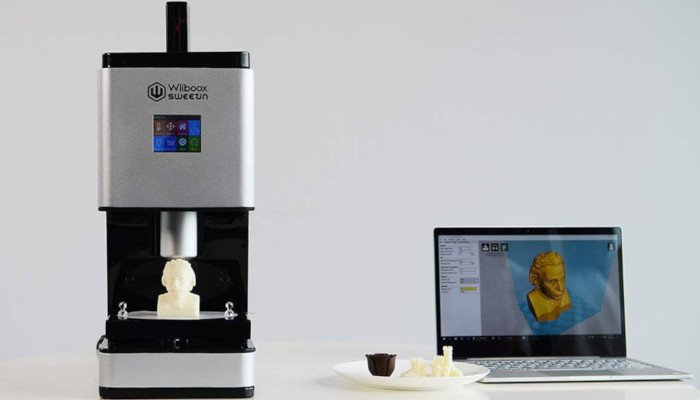
2. FoodBot S2
- Food printer price: $2,100 — Available on 3DPrintersOnlineStore here
- Max print volume: 150 x 150 x 73 mm
- Food print speed: 15 – 70 mm/s
- Accuracy: 100 microns
Pros
Versatile.
Changeable speeds based on the accuracy and intricacy of your print.
Ability to use nozzles ranging from 0.3 to 1.5mm based on your needs.
5.2 inch touchscreen and sleek UI add to the atmosphere.
Cons
Can fail from time to time.
A versatile food 3D printer, the FoodBot S2 can print chocolate, biscuit, jam, cheese, mashed potatoes, toffee and more! You can change the speed between 15 and 70 mm/s based on the accuracy and intricacy of your print, and alter the temperature based on your preferences.
What stands out however is how great the printer itself looks — if Apple ever made a 3D printer, this is how I imagine it would look. The design is futuristic, elegant and modern; it really adds a sci-fi feel to any kitchen. The 5.2 inch touchscreen and sleek UI add to this atmosphere.
As for accuracy, you’ll have no problem creating detailed food 3D prints with its 100 micron precision, with the ability to use nozzles ranging from 0.3 to 1.5 mm based on your needs. It comes with its own free 3D software to slice and prepare prints, and prints via either USB or SD card.
FoodBot stress how hygienic their S2 food printer is. The actual food filament never touches the printer, as it comes in disposable plastic dispenser tubes and is extruded straight through the nozzle. This makes keeping the printer clean and safe very easy, as there are no innards to clean, just the nozzle. Overall, it’s an impressive and easy to use food 3D printer with a wide variety of materials and uses.
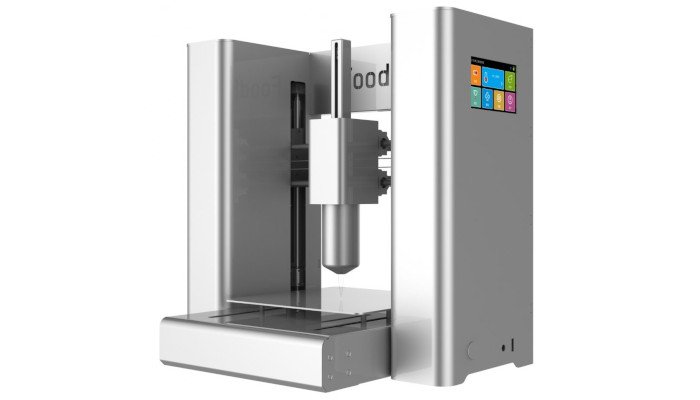
3. Zmorph Fab (with Thick Paste Extruder Add-on)
- Price: $3,999 — Available at Matterhackers here / Available on 3DPrima Europe here
- Maximum print volume: 235 x 250 x 165 mm
- Thick paste extruder available here
Pros
Reliable, tough and gritty.
Known for being unbelievably versatile.
Good layer resolution and excellent stability.
Cons
Zmorph do not certify that the printer’s food prints are edible or take any accountability for that.
Most people know of the Zmorph Fab as a workhorse 3D printer, drawing praise for its reliability, toughness and grit. It’s also known for being unbelievably versatile — it can be converted from a 3D printer into either a CNC mill or a laser engraver!
Now in addition to this, if you buy Zmorph’s thick paste extruder you can also print in chocolate, nutella, cookie dough and a few other food 3D printer filaments too. It prints pastes in a similar way to how it prints plastic filaments, so you benefit from the Zmorph Fab’s 50 micron layer resolution and excellent stability.

All the technology developed for the Zmorph Fab that makes it one of the best 3D printers around also works perfectly to make it a great food 3D printer. The accuracy, reliability and stability all apply in food 3D printing, and the Zmorph VX therefore is the perfect 3D printer for those who want a printer that can do it all. It’s ideal if you’ve been looking for both a food 3D printer and standard FDM 3D printer, but don’t want to buy two printers.
It is worth noting however that Zmorph do not certify that the printer’s food prints are edible or take any accountability for that. The add-on is therefore more of a fun extra to have fun at home with your family, but not for those looking to sell chocolate 3D prints or to use it in a restaurant. The printer was not built with food 3D printing strictly in mind, but it is a fun add-on for $250.
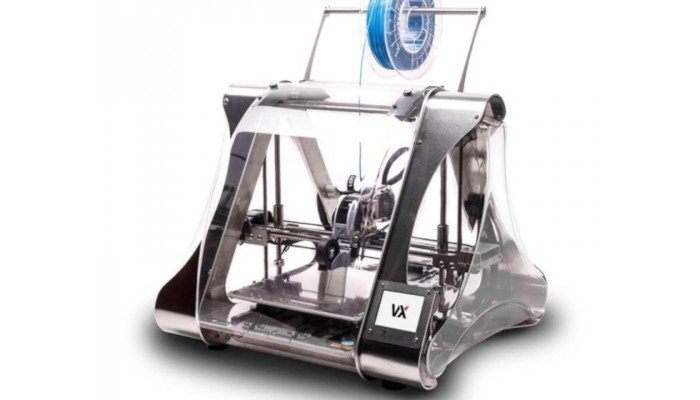
4. Createbot 3D Food Printer
- Price: $2,115 — Available on 3DPrintersOnlineStore here
- Max food 3D print size: 150 x 150 x 100 mm
- Speed: 20 – 30 mm/s
- Precision: 100 microns
Pros
Can be bought in 3 different colors.
Similar in speed, price and appearance to the Foodbot.
Ability to operate the printer from your laptop, tablet or smartphone.
Cons
Slow speeds.
There are definite similarities between the Createbot and Foodbot printers, in size, speed, price and appearance. One key difference however is that the Createbot food 3D printer comes in three different colors: Champagne Gold, Simple Silver and Rose Gold. All three options portray a stylish, expensive-looking machine.

It can print many of the same ingredients as the Foodbot S2 3D printer, including chocolate, biscuit, red and green bean paste, lotus seed paste, and other foods. The actual print speed depends on the material used: it is recommended to use 20 mm/s for chocolate printing, and 30 mm/s for other materials.
A cool feature with the Createbot is the ability to operate the printer from your laptop, tablet or smartphone. You can also carefully control the printer’s temperature to ensure prints retain their nutrition and print with the right consistency. Import your 3D printer model into Repetier-Host 3D slicer, slice it, and you’re ready to go!
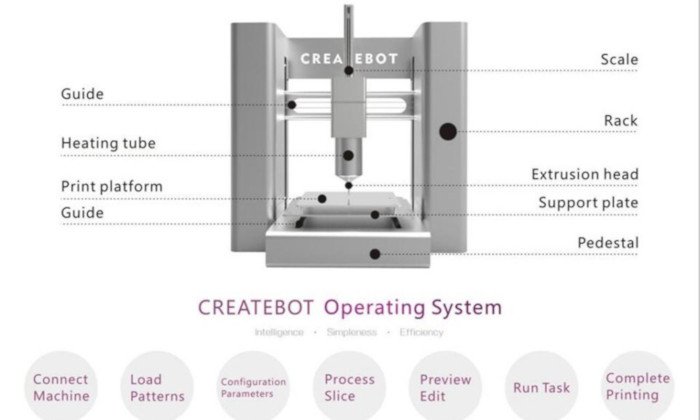
5. Mmuse Delta Food 3D Printer
- Price: $1,140 — Available on 3DPrintersOnlineStore here
- Maximum print volume: 100 x 100 x 100 mm
- Speed: 150 – 300 mm/s
Pros
High printing speeds.
Comes fully assembled and ready to print.
Lighter than most food 3D printers.
Cons
Don’t expect pinpoint accuracy.
The only delta 3D printer on our list, the Mmuse delta brings the advantages of high printing speeds associated with these types of 3D printer to the food sector. Whereas some other food printers max out at around 70 mm/s, Mmuse claim the delta food 3D printer can print between 150 and 300 mm/s — depending on the quality of print and type.
It can print materials including chocolate, pancake, candy and tomato sauce, so you have the option of either sweet or savory. Unlike most delta printers it isn’t a DIY 3D printer, instead coming fully assembled and ready to print — saving time and effort. It’s also lighter than most of the other food 3D printers, at a very manageable 5kg.
Rather than offer a wide variety of nozzle sizes, the Mmuse delta sticks with the standard FDM 3D printer nozzle diameter of 0.4mm. It’s more of a fun food 3D printer for kids to enjoy and play with than an industrial food printer for restaurants. Don’t expect pinpoint accuracy and Michelin-level food presentation, but you can definitely still enjoy creating fun food prints of your favorite kids’ TV characters and other fun 3D printed food projects.
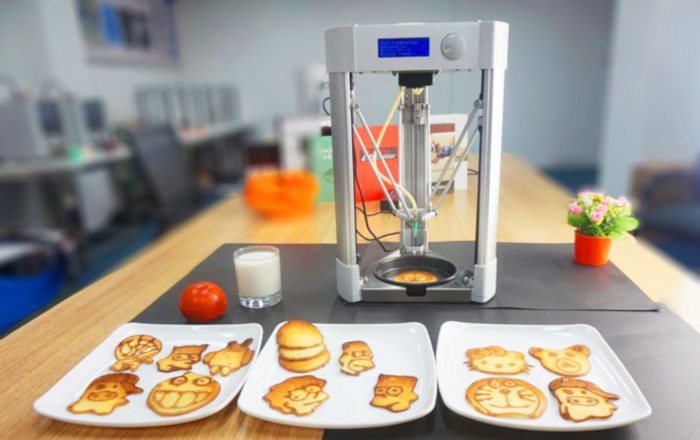
6. Foodbot D2 — Dual extruder food 3D printer
- Price: $5,999 — Available on 3DPrintersOnlineStore here
- Maximum print volume: 80 x 150 x 100 mm
- Print speed: 25 – 50 mm/s
- Precision: 100 microns
Pros
Can print two materials concurrently.
The 3.5 inch touchscreen and ergonomic UX make food printing a breeze.
Have solid, sheet metal frames which aid stability, accuracy and precision.
Cons
Pretty expensive.
An upgrade on the Foodbot S2 that also features in our ranking, this extraordinary machine not only can print intricate food structures, but can print them with two materials concurrently!
The dual heads mean you can print either two different colors of the same food material, or two different materials. So you could create your own design in part toffee and part chocolate, or any other combination you want. Additionally, the 3.5 inch touchscreen and ergonomic UX makes food printing a breeze.
This second print head is very useful in commercial business opportunities such as creating custom edible brand logos that need to be in two different colors or materials. Custom cake decorations, intricate chocolate pieces, mini portrait pieces and busts, and general personalized gifts are made easy with the Foodbot D2.
Both the D2 and S2 food printers have solid, sheet metal frames which aid stability, accuracy and precision food 3D printing. The D2 prints at between 25 and 50 mm/s dependent on the material printed, and can be converted to use nozzles varying from 0.4mm to 1.5mm. It’s heavier however, at around 25kg — so keep this in mind if you need something very portable.
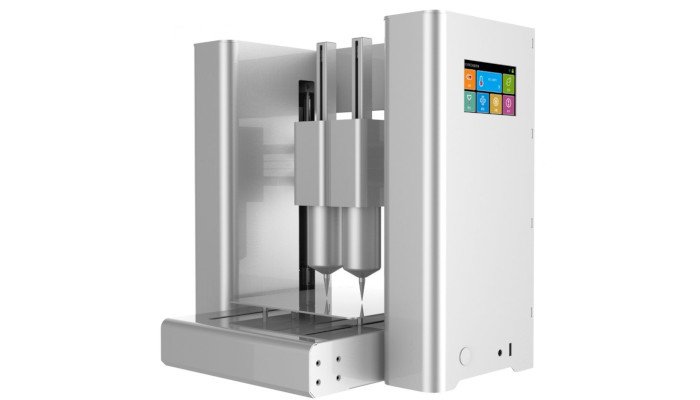
7. Mmuse Touchscreen
- Country based: China
- Food 3D printer price: $5,700 — Available on 3DPrintersOnlineStore here
- Print volume: 160 x 120 x 150 mm
Pros
Futuristic and beautiful.
Fast speeds of between 30 and 60 mm/s.
Can print via WiFi, USB or SD card.
Comes fully assembled.
Cons
High price.
Another chocolate 3D printer, the Mmuse is a food 3D printer that looks like something out of the matrix. It’s futuristic and beautiful, selling itself as a chocolate making experience, not just a 3D printer. It’s fast too, able to print between 30 and 60 mm/s of delicious 3D printed chocolate.
There’s a reason for the high price. The Mmuse chocolate 3D printer is designed to be as convenient as possible to operate, so you can 3D print food via WiFi, USB or SD card. The beautiful touchscreen on the Mmuse makes printing a breeze, and features a strong aluminium shell. Mmuse also claim it utilizes an ‘intelligent temperature control technology’, allowing it to 3D print chocolate at the perfect temperature so the chocolate prints as smoothly and evenly as possible. Additionally, Mmuse have designed the printer nozzle to be as easy to clean and replace as possible to maintain hygiene over years of printing.
It comes fully assembled, so all you need to do is get hold of the chocolate bean filament, choose the print settings you prefer, and let it print away. The easy-to-use touchscreen makes delicious chocolate printing a pleasant experience. If you’ve got the money and you love chocolate enough, this may be the one for you. Also, if you’re a chocolatier and want to automate some aspects of production, this could be perfect.
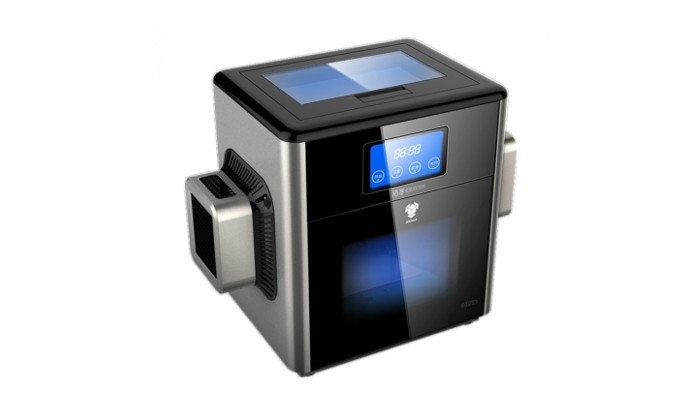
8. Natural Machines Foodini
- Country based: Spain
- Food 3D printer price: $4,000
- Print volume: 250 x 165 x 120 mm
Pros
Created to streamline the repetitive tasks which are time consuming and difficult to do by hand.
A versatile food 3D printer.
Very advanced.
Cons
Not suited for beginners.
One of the most well-known food 3D printers out there, the Foodini is a food 3D printer breaking barriers left, right and center in the foodtech sector. Foodini, made by Spanish firm Natural Machines, recognize that though cooking is an enjoyable process for many, there are many tasks that could be automated. The Foodini food 3D printer was therefore created to streamline the repetitive tasks which are time consuming and difficult to do by hand.
Foodini is a versatile food 3D printer, able to print pizza, spaghetti, and even burgers. Its glowing reviews led to fairly wide use in restaurants, like the byFlow Focus has similarly achieved. Restaurants which use the Foodini include London’s Food Ink restaurant, the entirely 3D printed restaurant, as well as La Endeca at Hotel Arts, in Barcelona.
Overall, the price is steep, but this is because of how advanced the Foodini is. It’s less of a cooking tool for use within homes and more of an industrial tool for professional kitchens, but this doesn’t make it any less of an incredible foodtech achievement.
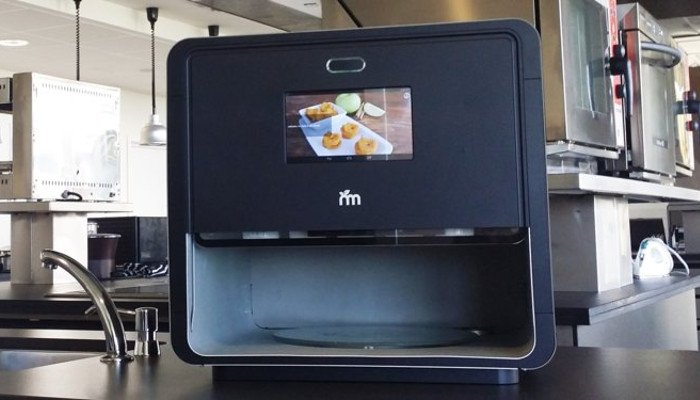
9. byFlow Focus
- Country based: Netherlands
- Food 3D printer price: €3,300
- Print volume: 208 x 228 x 150 mm
Pros
Reliable and easy to use.
Can take a multitude of materials, and switching between them is quick and easy.
Used in a number of restaurants and businesses.
Cons
Can be slow at times.
The byFlow Focus is a sleekly designed food 3D printer with a surprisingly wide reach in businesses around the world. Unlike most fanciful and futuristic machines that seem like they won’t see wide adoption for twenty plus years, the byFlow Focus is a 3D food printer which is already used in a number of restaurants and businesses.
Part of the reason is due to its reliability and ease of use. It can take a multitude of different 3D food printer materials, and switching them round is quick and easy. What’s more, you can even add your own recipes to the machine to 3D print with the ingredients you enjoy most. This allows you all the freedom you need to print any chocolate, pastry, or other 3D printed food dish you like, and byFlow even have over 50 downloadable 3D designs for free on their website.
As a result, businesses such as B2B chocolatier Barry Callebaut giant use byFlow Focus food 3D printers, as well as well-reputed chef Jan Smink in his ‘Restaurant Smink’ restaurant.

10. Choc Edge Choc Creator 2.0 Plus
- Country based: UK / China
- Food 3D printer price: €2,330
- Print volume: 180 x 180 x 40 mm
Pros
Picturesque and innovative.
Features a large and responsive touchscreen.
Easy to remove the nozzle and replace the 30ml metal syringe.
Cons
Need an active cooling system.
Originally based out of a uni campus, Choc Edge is now thriving as a leading food 3D printer manufacturer. The Anglo-Chinese chocolate 3D printer company’s third food 3D printer, the Choc Creator 2.0 Plus, is a picturesque and innovative machine. Though it prints edible objects, the Choc Creator still utilizes the same layer-by-layer method as with Fused Deposition Modeling. Retailing at just under $3,000, it’s a great option for niche bakers and chocolatiers out there.
A few reasons why the Choc Edge Choc Creator 2.0 Plus is an industry leader are firstly how easy it is to use. The chocolate 3D printer features a large and responsive touchscreen for easy access and printing. The 0.8mm nozzle is easily removed and changed based on the 3D food material used, with the 30ml metal syringe just as easy to replace. Overall, it’s a one of the best chocolate 3D printer machines on the market, and prints in the same way as your average FDM 3D printer.

Bonus: The Food 3D Printer That Never Happened — 3D Systems ChefJet & ChefJet Pro
- Country based: USA.
- Food 3D printer price: $5,000 & $10,000.
- Print volume: 203 x 203 x 203 mm.
The ChefJet food 3D printer created by industrial 3D printer giant 3D Systems is an unfortunate case.
3D Systems bought Sugar Labs in 2013, suggesting there may be movements from the American company in the foodtech sector in the future. Then, when they announced and demonstrated the ChefJet Food 3D Printer throughout 2014 and 2015, people couldn’t wait to get their hands on this incredible piece of tech. It could make 3D food structures out of sugar with flavours including chocolate, vanilla, mint, sour apple, cherry, watermelon, and even more!

But it wasn’t to be. Some internal friction within the company meant that the project was put on hold for several years. Then in late 2017, 3D Systems announced a partnership with CSM Bakery Solutions to create and distribute the food 3D printers along with custom-made food 3D printer material.
Therefore, though the ChefJet 3D printer isn’t out yet, we still felt it was worthy of its place on this list as it will get a release soon, and has demonstrated its ability to 3D print food. We look forward to seeing how far the ChefJet and ChefJet Pro can push 3D printed food in the future. The ChefJet is to retail at $5,000, whilst the ChefJet Pro will retail at $10,000.




